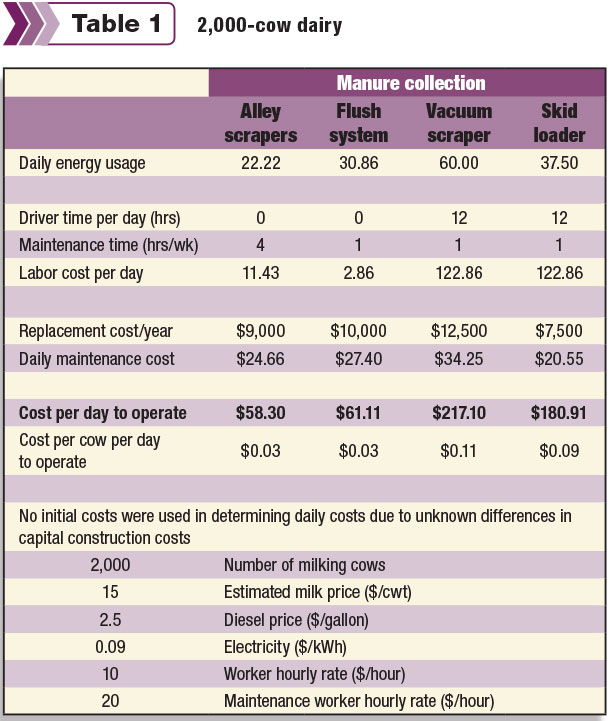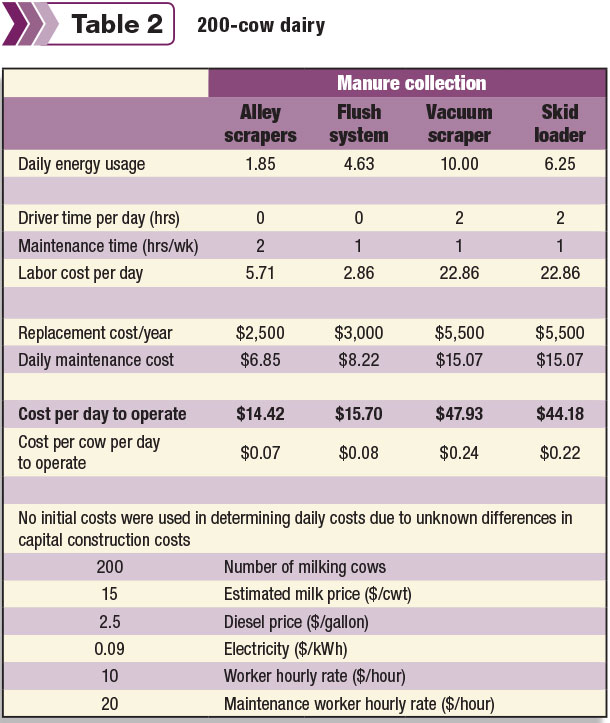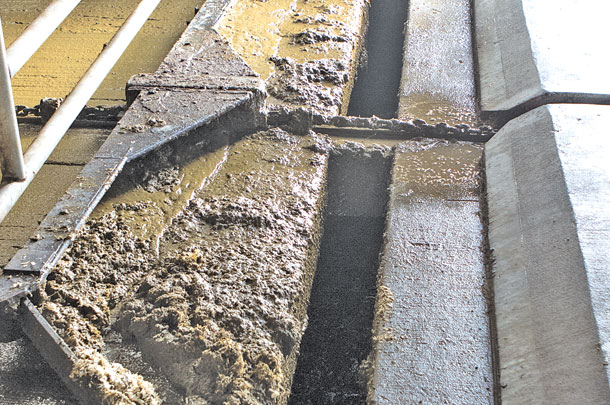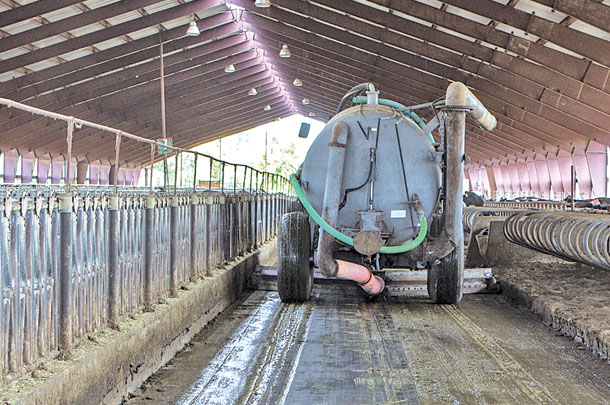Labor is an important discussion point when looking at any aspect of your operation. Labor is even more significant when it comes to the manure management system you select.
Different manure management systems have an impact on the workforce needed and sometimes the effect can take producers by surprise.
 Evaluating the labor, operating cost, maintenance, benefits and challenges of each manure management system can help provide insights on which system would be the best fit for your operation.
Evaluating the labor, operating cost, maintenance, benefits and challenges of each manure management system can help provide insights on which system would be the best fit for your operation.
Skid loaders
Labor: Depending upon the size of the dairy you may be scraping with a skid loader half an hour in the morning and half an hour in the evening or it could be running 24 hours per day, seven days a week. Even if you as the owner are operating the equipment, an hourly rate should be accounted for in the cost to run the skid loader.
Operating cost: Skid loaders burn between 1.5 and 3 gallons per hour. At $2.50 per gallon, that is $3.75 to $7.50 per hour. Calculate the operating cost based on the number of times the equipment operates.
Maintenance: In addition to maintaining the skid loader, don’t overlook the number of gates, freestall loops or garage doors that might need replacing in a year due to operator error. Depending upon use, skid loader tires need to be replaced every 300 to 700 hours.
Benefits: Skid loaders can be used in any weather condition and for other tasks around the farm.
Challenges: Scraping alleyways can only take place when cows are in the milking parlor, which can delay the cows’ return to feed, water and rest after milking. Getting cows back into the stalls post-milking puts pressure on the individual operating the skid loader to complete the job as quickly as possible. Rushing can lead to manure waves in the stalls, broken equipment or poor cleaning.
Alley scrapers
 Labor: No work is needed to operate the alley scraper.
Labor: No work is needed to operate the alley scraper.
Operating cost: Minimal energy is required.
Maintenance: One of the challenges with alley scrapers is in-barn maintenance. Maintenance isn’t a big expense, but it does require assigning the maintenance to an individual. It’s key to work with dealerships to follow a proper maintenance schedule.
Benefits: Cows can be in the pens when scraping takes place, which allows them to come back from the parlor to feed, water and rest more quickly after milking. As a result, scraping the alleyways can be done on a higher frequency throughout the day, keeping the lanes and the cows cleaner.
Alley scrapers also relieve pressure, as no individual is needed to clean the alleyways as seen with other methods, like a skid loader.
Challenges: Cable or chain wear is always a concern; however, recent advancements in drive units on alley scrapers have reduced wear and tear on cables, as well as replacement frequency.
Vacuum scrapers
 Labor: Similar to the skid loader – how frequently will the vacuum scraper be used, what is the per-hour rate paid?
Labor: Similar to the skid loader – how frequently will the vacuum scraper be used, what is the per-hour rate paid?
Operating cost: Depending on the engine size on a self-propelled or a tractor-towed unit, a vacuum scraper can use between 3 and 5 gallons of fuel per hour. At $2.50 per gallon, that is $7.50 to $12.50 per hour. Calculate the operating cost based on the number of times the equipment operates.
Maintenance: Regularly scheduled maintenance is an important consideration for a vacuum scraper. Consider the cost of maintenance and replacement parts.
Benefits: Not much different than sweeping dirt at home, vacuum scrapers pick up manure and deposit it into a container as it goes through the barn. Vacuum scrapers can eliminate the need for collection systems between barns.
Challenges: Making turns and reversing can be a challenge; it is rare to find a barn designed for a vacuum scraper. It can also take some time to open gates and doors to get a machine in and out of the barn.
The vacuum scraper can be massive when loaded. Frequently concrete in existing facilities is not designed to handle the weight, and the concrete can crack and break. Consider if your barn can hold the weight of a vacuum scraper.
Flush systems
 Labor: No work is needed to operate the flush system.
Labor: No work is needed to operate the flush system.
Operating cost: When building a barn with a flush system, consideration needs to be given to the slope of the barn and availability of water. Once designed for a flush system, a skid loader may work in the future, but your barn will be locked into a flush system.
Benefits: Cows can be in the pens when flushing takes place, allowing them to come back from the parlor to feed, water and rest more quickly after milking. Alleyways can be cleaned at a higher frequency if water is available.
Challenges: With flush systems, the biggest challenge is the amount of water – fresh and recycled – to efficiently flush alleys. It is recommended that 50 gallons of fresh and 60 gallons of recycled water is available per cow per day, for a total of 110 gallons per cow per day.
There are a lot of factors that go with adding or upgrading a barn cleaning system. In the end, farmers need to weigh the investment costs, maintenance requirements, their geographical location and the labor required to run the system to make the best choice for the farm. PD
We have developed an in-depth calculator that can assess the cost of each manure system for individual dairymen. This calculator gives insight into the cost and related savings that can be gained from optimizing your manure system. To have an assessment done for your operation, contact your local GEA Houle dealer.
PHOTO 1: Skid loader.
PHOTO 2: Alley scraper.
PHOTO 3: Vacuum scraper.
PHOTO 4: Flush systems. Photos by Mike Dixon.
Jeramy Sanford is a field manager & manure specialist with GEA Farm Technologies. Email Jeramy Sanford.




